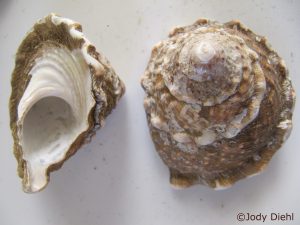
A Snail may like to take it slow, but they are anything but boring. Snails belong to the most diverse group of marine invertebrates (Phylum Mollusca) and have developed amazing adaptations for protecting their soft bodies. In addition to various toxins and defense mechanisms, snail shells are found in a dizzying array of shapes and sizes. By looking at the shape of a snail’s shell, we can determine what a snail eats and some important details about how a snail fits into its environment.
 Wavy Turban Snail (Megastraea undosa), a popular mollusk in CIMI waters
Wavy Turban Snail (Megastraea undosa), a popular mollusk in CIMI waters
Photo Credit: Jody Deihl
Marine snails eat a wide variety of food. Some are strictly herbivorous and eat only algae, some carnivorous snails eat only meat, some eat only dead organisms, and others have an omnivorous diet. Snails use a radula, or tiny procession of teeth, to grind away at their food. This radula acts like a chainsaw by cutting through algae, shells, muscles, or other obstacles through repetitive grinding and shredding over minutes to days. The radula’s chitonous teeth may be arranged differently between herbivorous and carnivorous snails. Radula teeth are arranged identically in rows and can be used to differentiated species under a microscope. The large muscular foot on the bottom of a snail can be used to manipulate prey, graze around hard substrate, or move to another food source.
A snail’s function in an ecosystem will influence how an individual shapes its shell, and the shell will in turn help the snail function more efficiently. For example, a snail that lives in an area where food is only found in tight spaces will go hungry if it has a big, clunky shell. This relationship is called functional morphology, and its study is a complicated intersection of biology, physics, mathematics, and chemistry.

Basic anatomy of a marine snail, as viewed from the bottom
Photo Credit: Dr. Shimek (2014), Reef Keeping Magazine
At CIMI, we have many species of marine snails that love to say hello on snorkels and tide pool adventures. Some of our favorites include: Wavy turban snails (Megastraea undosa), chestnut cowries (Neobernaya spadicea), Kellet’s whelks (Kelletia kelletii ), and kelp snails (Norrisia norrisii). Two characteristics of snail shells alone can provide a window into their diets and likely habitat.
- Direction of shell growth
If a snail’s shell is heavier and grows up towards the sun, the snail is likely herbivorous, preferring to feast on algae over other food sources. These heavy shells allow the snail to graze algae or seagrasses growing on hard substrates and provide a solid protection against predators looking for a slower meal. Herbivorous snail shells are often found with other organisms living on top, such as tube worms or encrusting alga.
If a snail’s shell is lighter and grows sideways like a bone, the snail is likely carnivorous, meaning that it eats organic flesh. Lighter shells allow snails to move easily around narrow bones and body openings without weighting them down.
- Shape of shell opening
Shells with a round, salad bowl-like shape are likely home to herbivorous snails. This allows a larger, slower snail to live inside and retreat in the event of predation or being flipped over by CIMI snorkelers.
Shells with a narrow, gravy bowl-like shape are likely home to carnivorous or omnivorous snails. Snails that eat other animals are at risk for being eaten themselves by organisms with similar predatory eating preferences. Narrow openings make it harder for predators to get at the mollusk’s soft body and give a differentiated space for the foot to move food around the radula.
The next time you see a snail, remember that snail shells tell a delicious story of where snails have been, where they’re going, and what they’re eating along the way.

Cheat sheet for snail shell shape and diet preferences
Photo credit: Dalton Koss HQ
To learn more about how to identify carnivorous snails, follow this link: https://msnucleus.org/membership/html/k-6/lc/ntenvn/3/lcne3_5a.html
To learn why some snail shells have perfectly round holes make for necklace strings, click here: https://daltonkosshq.wordpress.com/category/marine-facts/page/3/
To learn more about cone snail venom and radulas, check out this blog: http://seaurchinsmag.com/blog/carnivorous-marine-snails-tina-holt/
To understand the differences between terrestrial and marine snails, click here: http://www.molluscs.at/gastropoda/index.html?/gastropoda/morphology/feeding.html
Written by: Alyssa Bjorkquist
Images:
- Wavy Turban Snail: https://beachtreasuresandtreasurebeaches.files.wordpress.com/2012/02/wavy-turban.jpg
- Basic snail anatomy: http://www.reefkeeping.com/issues/2004-05/rs/images/image008.jpg
Carnivorous vs. herbivorous snails: https://daltonkosshq.files.wordpress.com/2015/02/slide1.jpg?w=720


